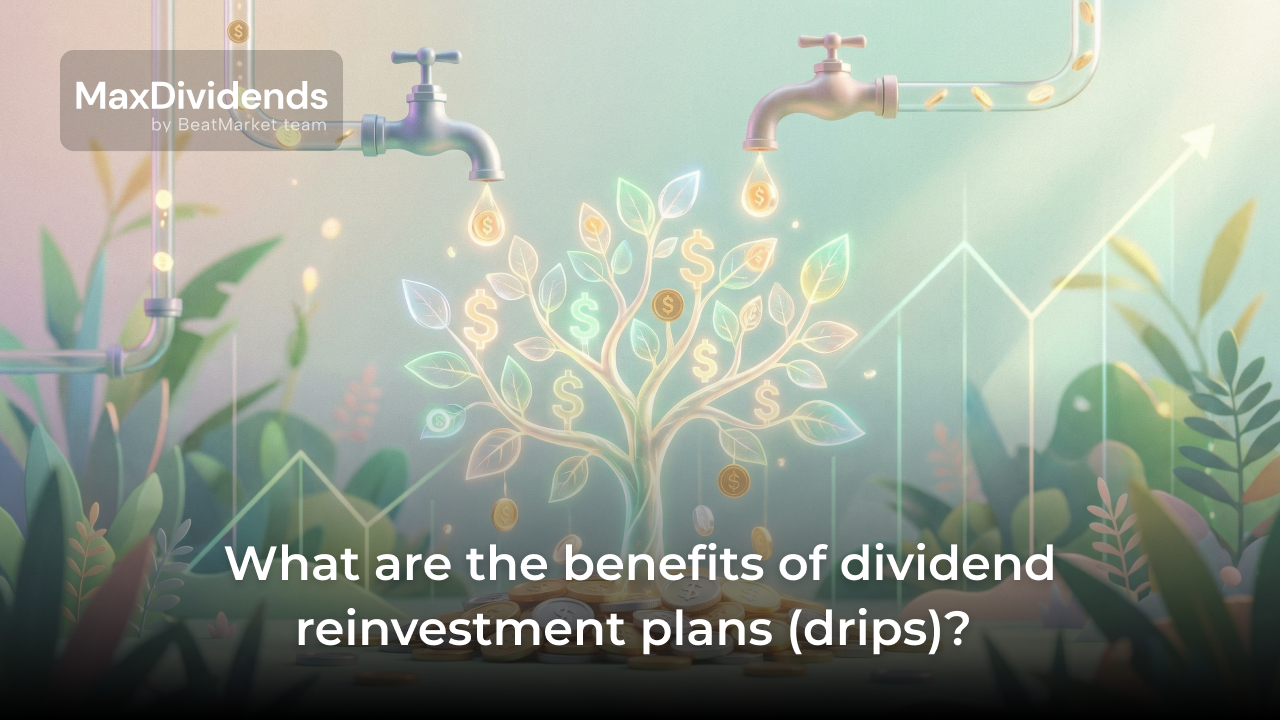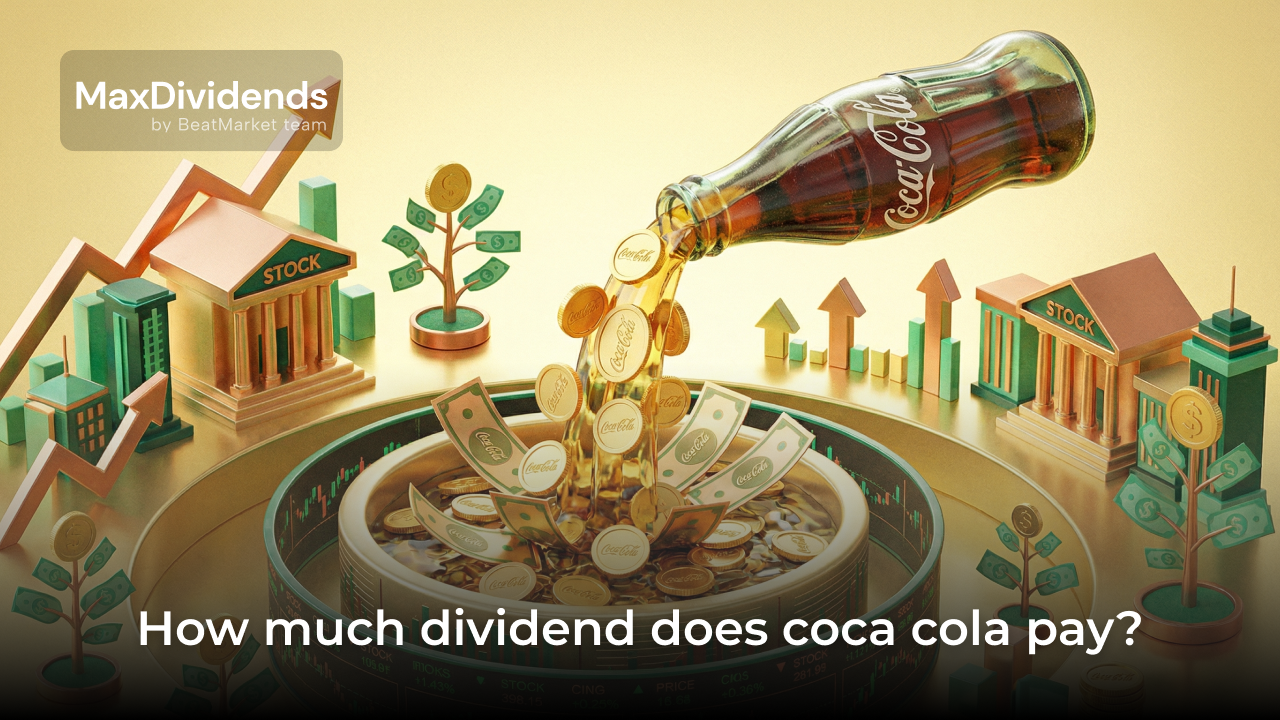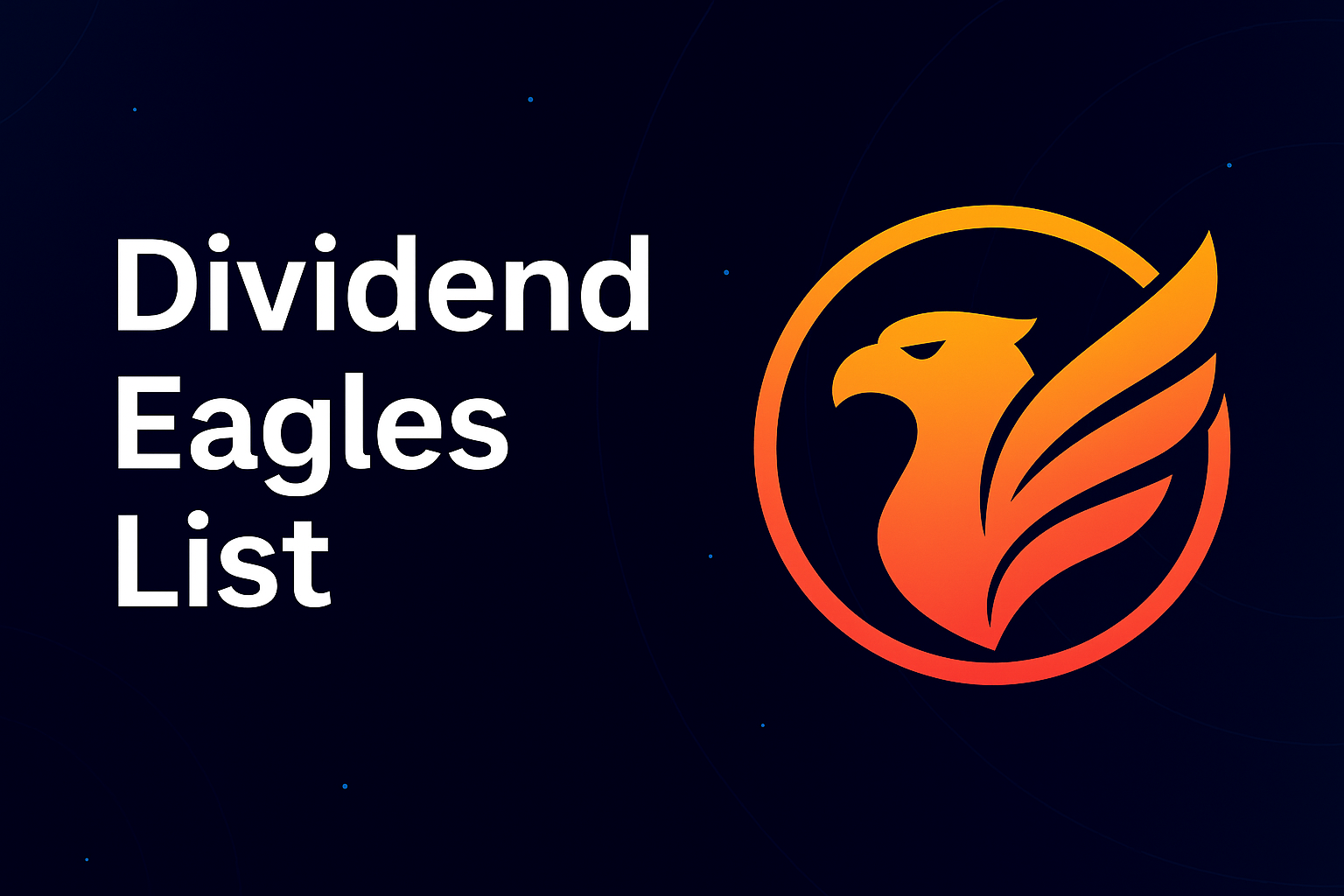Key Takeaways:
- What Are Dividends: Dividends are regular cash payments that companies distribute to shareholders from their profits, typically paid quarterly or monthly. They provide passive income and serve as an indicator of a company’s financial health and confidence in future earnings.
- Investment Types That Pay Dividends: Besides individual company stocks, investors can earn dividends from ETFs, mutual funds, REITs, and Business Development Companies (BDCs). Monthly dividend payments are primarily available through REITs and BDCs, while most traditional stocks pay quarterly.
- How to Start Dividend Investing: Use stock screeners to find dividend-paying companies, evaluate them using key metrics like dividend yield (annual dividend divided by stock price) and payout ratio (percentage of earnings paid as dividends). Focus on companies with sustainable payout ratios between 20-60% and consistent dividend growth history.
- Building a Dividend Portfolio: Diversify across sectors and companies, limiting individual stock exposure to 5% and sector concentration to 10-15% of your portfolio. Choose between individual stocks for higher potential returns or dividend-focused ETFs for instant diversification, and consider reinvesting dividends to accelerate wealth growth through compounding.
Dividend stocks are stocks of companies that distribute a portion of their profits among shareholders. These are typically regular payments made on a quarterly or monthly basis.
Such securities are considered an excellent option for passive income. They can form the basis of a long-term wealth creation strategy.
In this article, we will discuss which investment can pay the owner dividends and provide tips on constructing a portfolio.
Table of Contents
How to Invest in Dividend Stocks
It is not enough to know what investment may pay the owner in dividends. It is essential to understand how to properly build a diversified portfolio of these assets.
To select the best individual dividend stocks, time and effort will be required. Below is a step-by-step guide for finding reliable high-yield payers.
Pros and Cons of Investing in Dividend Stocks
Investing in dividends has five advantages:
- The opportunity to have a reliable source of passive income. This money can supplement social security payments during retirement. If a person is going to reinvest dividends, they will accelerate capital growth.
- The likelihood that the dividend return on the investment portfolio will increase over time.
- Tax efficiency. Dividends from most American companies can be classified as qualified dividends. As a result, they are taxed at capital gains rates (0%, 15%, or 20% depending on income).
- Reduced portfolio volatility. Stocks that pay dividends tend to lose less value during economic downturns.
- The ability to use additional criteria to assess the financial health of a company. The most important of these is the stability of shareholder rewards. By paying dividends, a company demonstrates confidence in its future earnings.
When taking advantage of the benefits of a dividend strategy in wealth management, it is important to remember its drawbacks. The main disadvantage is the limited growth potential of dividend-paying companies compared with growth companies. This leads to a slower increase in the market value of their shares.
Another major disadvantage is that dividends are not guaranteed. They can be cut or cancelled at any time. Diversification across companies and sectors is therefore extremely important.
Dividend investors run the risk of falling into a yield trap. To avoid this, it is important to analyse companies thoroughly.
Investment Risks
All exchange-traded assets have varying degrees of risk. Equity securities are considered riskier than bonds. Income investments are associated with:
- Interest rate risk. Various factors may cause the dividend return on selected securities to fall below the risk-free interest rate.
- Inflation. Inflation risks relate to the possibility that an investor’s cash flow may grow more slowly than consumer prices. The same can happen to asset prices, leading to a loss in the purchasing power of capital.
- Credit risks. This is the probability that a selected company will go bankrupt. This risk is particularly significant when selecting small-cap stocks and high yield bonds.
Past performance is not a guarantee of future results. The price of an asset may fall. The decision to invest always involves the risk of loss of principal.
Investments in foreign securities involve additional risks, mainly currency and political risks.
Investing for Income: Dividend Stocks vs. Dividend Funds
Dividends can be received not only from individual stocks but also from ETFs. Their advantage is the instant portfolio diversification they offer investors.
The net assets of an ETF are made up of the securities of many companies. They include not just a few stocks, but several sectors of the economy. Such funds typically track an index, such as the S&P 500 Dividend Aristocrats.
A disadvantage of ETFs is the presence of fees. However, index funds have an expense ratio that does not exceed a fraction of a percent. Another downside is the inability to generate above-average returns. An investor who selects individual stocks can only focus on the most profitable companies.
One way to enhance return on investment is through reinvesting dividends. Many funds and some companies provide investors with beneficial automatic dividend reinvestment plans.
How to Evaluate Dividend Stocks
Key metrics to evaluate include:
- Dividend yield;
- Payout ratio;
- Dividend coverage ratio.
Auxiliary ratios are used for a more in-depth analysis of dividend-paying stocks.
The dividend growth rate indicates the percentage increase in dividends per share on an annual basis. This ratio is usually calculated over 3, 5, or 10 years. A steady increase in payments reflects the overall financial health of the company. This indicator is also used to forecast future earnings growth rates.
Earnings yield is the inverse of the price-to-earnings (P/E) ratio. This metric helps to understand the profitability of investments and the efficiency of the business. For example, if a company has a market capitalization of $100 billion and earnings of $10 billion, then every dollar invested in the company will generate 10 cents.
The price-to-dividend ratio is calculated by dividing the stock price by the annual dividend. This ratio shows the cost of one dollar of future earnings. Investors often use this multiplier instead of the P/E ratio because it is considered more reliable. This is because earnings can be manipulated.
The debt-to-equity ratio is calculated by dividing total debt by total assets. This ratio is not directly related to dividends but is one of the indicators of a company’s financial health. An optimal D/E ratio is considered to be in the range of 1 to 1.5. A ratio that is too low indicates inefficiency, while a ratio that is too high indicates a risk of bankruptcy.
When assessing a company’s health, it is important not only to look at the current values of these multiples, but also to study their historical fluctuations and compare them with those of competitors.
In addition to the mentioned ratios, it is necessary to consider the business model and macroeconomic risks. It is useful to review the annual report of the selected company.
It is important to remember that dividends are not guaranteed. In difficult times, even dividend kings can reduce or eliminate their dividends. For example, 3M Company halved its dividend in 2024 after 64 years of annual increases.
What Are Dividend Stocks?
Dividend stocks are shares that provide the owner with regular payments. Their source is the profits of the company. The best dividend stocks are those with growing earnings. Shares with the highest current dividends often turn out to be a yield trap.
The stability of dividend payment can only be guaranteed by well-established companies. Companies that have consistently increased their shareholders’ dividends for 25 consecutive years or more are known as dividend aristocrats.
What Are Dividends?
Regular dividends are a portion of a company’s earnings that is paid to shareholders on an ongoing basis. The amount is recommended by the board of directors based on the company’s financial results and dividend policy.
Payments can be monthly, quarterly, semi-annual, or annual. Special dividends may also be declared in the event of a one-time significant profit.
Companies pay dividends from excess cash. This is part of the profits that the company can afford not to reinvest in further development. Dividends are not guaranteed. If income falls or costs rise, a company has the right to cancel them.
Shareholders value dividends for their ability to enhance return on investment. Some investors use them as regular income that replaces salary.
How Do Dividends Work?
There are four key dates associated with dividend payments:
- Declaration Date – the day when the exact amount of the upcoming payment is announced.
- Ex-Dividend Date – the first day when purchasing a share does not entitle the buyer to receive the next dividend.
- Record Date – the day when the company compiles a list of Shareholders of Record. They will receive the upcoming payment.
- Payment Date – the date on which the company transfers the money.
In the past, the Ex-Dividend Date and Record Date did not usually coincide. Recently, however, all stock markets around the world have adopted the T+1 settlement rule, which means that these dates can now be identical.
Dividends are most often paid as quarterly payments. The company announces their amount per share. For example, if a company pays $1 each quarter, then an investor who owns 10 shares will receive $10 per quarter or $40 per year.
Consistently rising dividends are seen as an indicator of financial health. A reduction in payments is one of the warning signs of potential problems within the company.
Does It Matter When You Buy a Dividend Stock?
To be eligible for the next payment, shares must be purchased before the ex-dividend date. If the transaction takes place on or after this date, dividends will be paid to the seller of the shares.
However, on the Ex-Dividend Date, securities can be bought at a lower price. This is particularly true for companies that pay out dividends once every six months or annually. The share price usually falls by an amount close to the value of the dividend. In this way, the market compensates the buyer for not being entitled to the forthcoming payment.
Dividend Yield
The dividend return is the ratio of the annual value of the dividend per share to the current market value. It is expressed as a percentage. The calculation can be based on the last 12 months’ dividends. Another option is to use the forward dividend, which is calculated by multiplying the most recently declared dividend by the number of payments per year.
The dividend return depends on stock prices. Therefore, a high figure is not always a positive factor. It rises as a result of falling stock prices, which may indicate financial problems within the company.
Dividend Payout Ratio (DPR)
The payout ratio indicates the proportion of earnings that is paid out to shareholders. This multiplier is calculated by dividing the total dividends by the company’s net income. The calculation is expressed as a percentage over a period of one year.
| DPR Value | Assessment | Comment |
| Less than 20% | Acceptable | Most of the earnings are reinvested for growth. Management is not focused on minority shareholder income |
| 20% – 60% | Optimal | The business maintains growth potential. The company has reserves to sustain sustainable dividend payments |
| 60% – 100% | Undesirable | During unfavorable economic conditions, dividends may be reduced |
| More than 100% | Extremely undesirable | Dividends are paid from past earnings or through debt. There is a significant risk of reduction |
The table shows averages and does not apply, for example, to REITs. Different standards apply in this sector.
Dividend Coverage Ratio
The Dividend Coverage Ratio shows how many times a company can provide dividends out of its annual income. The higher this multiplier, the greater the sustainability of the dividend payment. For the ratio calculation, EPS is divided by the dividend per share. Another option is to divide net income by the total amount of dividends.
This indicator is sometimes modified to allow separate calculations of the dividend coverage ratio for ordinary and preference shares.
Finding Dividend-Paying Stocks
Stock screeners can be used to search for stocks. Such services are available on financial sites, as well as offered by online brokers and stock brokers.
The first step before you start paper trading is to choose an industry sector. Companies in sectors such as finance or energy tend to offer good yields. REITs, tobacco companies and others offer significant dividends.
Evaluating the Stock
The payout ratio and other multiples of the selected company should be compared with those of its peers. A dividend yield that is too high compared to other stocks in the industry is a red flag.
Only companies with solid fundamentals can offer investors with sustainable dividend yields. When selecting stocks, it is important to examine the dynamics of key indicators of financial health:
- income;
- profitability;
- debt levels;
- payout ratio, and others.
Deciding How Much Stock to Buy
Portfolio diversification is conducted across companies, sectors, and security types. The first step is to determine the asset allocation. A common investment advice is not to invest more than 5% of the capital in any single company. Sector concentration should not exceed 10-15%.
The chosen allocation is then maintained by rebalancing on a cost basis. When it comes to reinvesting dividends, an individual buys assets that have appreciated less in value. This helps to eliminate the resulting imbalance.
When selecting securities, it is important to consider not only the security of the investment and future payments, but also the taxation implications. This is particularly important if a high-income investor uses taxable brokerage accounts.
In such cases, it may be more advantageous to buy only those shares that pay qualifying dividends. The maximum tax rate is 20%. For ordinary dividends, the tax rate can be as high as 37%. The difference of 17 percentage points can significantly reduce the total return.
The Bottom Line
Dividends are not just for people who want to live off the interest on their capital. Their reinvestment can enhance compounding returns.
High yield stocks may seem like an attractive option for passive income generation. However, if an individual is interested in long-term financial well-being, they should carefully examine the financial health of the company.
Beginner investors will benefit from consulting with professional advisors. They can help you determine the optimal asset allocation and make recommendations for selecting individual securities.
FAQ
What kind of investments pay dividends?
In addition to individual company shares, dividends are also received from ETFs and mutual funds. Dividends can be earned on deposits in credit unions and investments in money market funds.
Which investment may pay the owner dividends?
Dividends are paid by individual companies, ETFs, and mutual funds on stocks or bonds, as well as credit unions.
Which of these investments may pay dividends: bonds, savings accounts, certificates of deposit, stocks?
The simplest answer to the question of which of these investments can provide dividends is individual company stocks and funds. In addition, savings accounts and certificates of deposit may yield dividends if they are opened at a credit union. When an investor uses a bank’s services, they refer to interest rates or interest income. Payments on bonds are called coupons.
Which investments pay dividends monthly?
There are 76 companies that pay out dividends monthly. Primarily, these are REITs and BDCs. Similar offerings can also be found among ETFs.
Article Sources
- Fama, E. F., & French, K. R. (2021). “Dividend yields and expected stock returns.” Journal of Financial Economics, 22(1), 3-25.
- Miller, M. H., & Modigliani, F. (2019). “Dividend policy, growth, and the valuation of shares.” The Journal of Business, 34(4), 411-433.
- Grullon, G., Michaely, R., & Swaminathan, B. (2020). “Are dividend changes a sign of firm maturity?” Journal of Business, 75(3), 387-424.
- Baker, M., & Wurgler, J. (2022). “A catering theory of dividends.” The Journal of Finance, 59(3), 1125-1165.
- Chen, H., & Shevlin, T. (2021). “The timing of dividend reductions: Signalling or free cash flow?” Journal of Financial Economics, 84(1), 275-298.
You Might Also Like
- What Is a Dividend Recap? Understanding This Financial Strategy
- Best MLP ETF: Understanding Dividend Stocks and How to Invest in Them
- What Is a Dividend Yield? Understanding This Key Investment Metric






